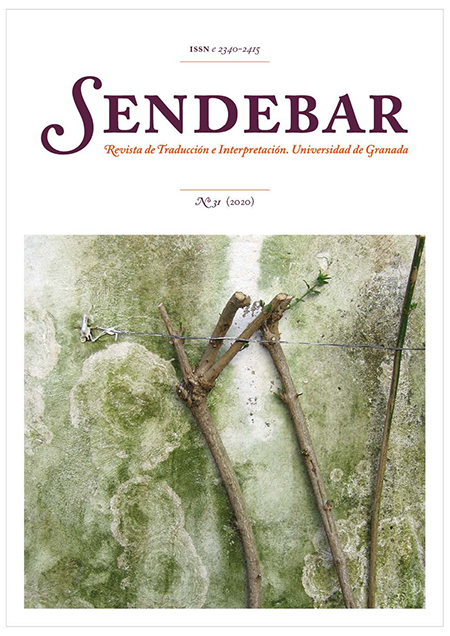Rendering Satire in Dubbing vs. Subtitling: A Case Study of the Arabic Translation of the American Sitcom The Simpsons
DOI:
https://doi.org/10.30827/sendebar.v31i0.13604Keywords:
AVT, Subtitling, Dubbing, Humour, Satire, Simpson’s model of satireAbstract
This study investigates translation strategies used to render satire of the American animated sitcom The Simpsons from American English into Modern Standard Arabic (Subtitling) and Egyptian vernacular (Dubbing). Besides, it attempts to unveil the contribution of language variety and translation modality in rendering satire. The study draws on Simpson’s (2003) stylistic model of satirical humour for understanding and analyzing satire. Furthermore, it adopts Mateo’s (1995) taxonomy to highlight the strategies used in dubbing and subtitling satire. Applying these two models helps in examining the issues posed by the nature of satire and the shifts in the configuration of satire when rendered from English into Arabic and the effectiveness of these shifts.
The findings of the study show that the socio-cultural nature of satire poses a serious challenge for translators. Furthermore, it has proved that subtitling tends to use the literal translation strategy to render satire in instances that share the same background of the source text and has failed in dealing with sociocultural based ones. Conversely, it was observed that dubbing tends to utilize the equivalent effect strategy, which proved to be sufficient when adapting sociocultural elements of satire. Finally, language variety and translation modality seemed to govern the efficiency of rendering satire in translation into Arabic.
Downloads
References
Abrams, Meyer H. (1993). A glossary of literary terms, (6th ed.). USA: Harcourt Barce College Publishers.
Ageli, Nuri. (2014). For better or for worse: The challenges of translating English humour into Arabic. Journal of Human Science. (23):414-426. Retrieved from
https://journal.uob.edu.bh/bitstream/handle/123456789/1229/JHS20140209.pdf?sequence=1
Al-Quinai, Jamal. (2005). Manipulation and censorship in translated texts. Paper presented at II AIETI. Actas del II Congreso Internacional de la Asociación Ibérica de Estudios de Traducción e Interpretación, Madrid, 9-11 February.
Altakhaineh, Abdel Rahman Mitib. (2017). Arabic compounds within the cross-linguistic compound taxonomy of Scalise and Bisetto (2009). Lingue e linguaggio. (16)1:101-118.
Applebee, Arthur. (1997). The language of literature: British literature. Evanston: McDougal Littell.
Attardo, Salvatore. (1994). Linguistic theories of humour. New York: Mouton de Gruyter.
Bremmer, Jan. & Roodenburg, Herman. (1997). Introduction: humour and history. A cultural history of humour from nntiquity to the present day. 1-10. Retrieved from https://www.rug.nl/research/portal/files/3215119/20146.pdf
Chaume, Frederic. (2012). Audiovisual translation: dubbing. Manchester: St Jerome.
Critchley, Simon. (2002). On humour (thinking in action). New York: Routledge.
Delabastita, Dirk. (1989). Translation and mass communication: Film and TV translation as evidence of cultural dynamic. Babel. (35)4:193-218.
Diaz-Cintas, Jorge. (2009). Audiovisual translation: An overview of its potential. Toronto: New Trends in Audiovisual Translation.
Diaz-Cintas, Jorge. & Remael, Aline. (2007). Audiovisual translation: subtitling. Manchester: St Jerome.
Dvořáková, Alena. (2012). Pleasure in translation: Translating Mill’s ‘Utilitarianism’ from English into Czech. ISFLL. (11)11:107.
Ferguson, Charles. (1959). Diglossia. Word. (15)2:325-340.
Florberg, & Lundborg. (2014). Understanding satire with The Simpsons. Sweden: Karlstad University thesis.
Gray, Jonathan (2009). Throwing out the welcome mat public figures as guests and victims in tv satire. In Satire TV: Politics and comedy in the post network era. Gray, Jonathan, Jones, Jeffery and Thompson, Ethan (eds.), 147-166. New York: NYU Press.
Gray, Jonathan, Jones, Jeffery & Thompson, Ethan. (2009). Satire TV: Politics and comedy in the post network era. New York: NYU Press.
Griffin, Dustin. (1994). Satire: A critical reintroduction. University of Kentucky Press.
Habermas, Jürgen. (1979). “What is universal pragmatics?”. Communication and the evolution of society. Boston: Beacon Press
Han, Qian. (2011). On untranslatability of English linguistic humour. Theory and Practice in Language Studies. (1)2:149-152. Retrieved from http://www.academypublication.com/issues/past/tpls/vol01/02/05.pdf
Kangas, Markus. (2018). Sounding out the bugle: Political satire in an “audio newspaper” format. Pro Gradu Thesis: University of Eastern Finland MA thesis
Kreuz, Roger & Roberts, Richard. (1993). On satire and parody: The importance of being ironic. Metaphor and Symbolic Activity. (8)2:97-109.
Perez-González Luis. (2014). Audiovisual translation: Theories, methods and issues. New York: Routledge.
Luyken, Georg-Michael. (1991). Overcoming language barriers in television: Dubbing and subtitling for the European audience. Manchester: European Institute for the Media.
Mateo, Marta. (1995). The translation of irony. Meta: Journal des traducteurs/Meta: Translators’ Journal. (40)1:171-178. Retrieved from https://www.erudit.org/en/journals/meta/1995-v40-n1-meta184/003595ar
Nemani, Faranak & Rasekh, Abbass Eslami. (2013). An investigation of the constraints in subtitling the conversations: On the role of cultural effects on variation. Journal of Educational and Social Research. (3)2:97-106.
O’Neal, Thomas. (1988). The translation of untranslatable jokes: Linguistic and cultural barriers in translating jokes. Albany: State University of New York.
Schmitz, John Robert. (2002). Humour as a pedagogical tool in foreign language and translation courses. Humor: International Journal of Humor Research. (15)1:89-114.
Simpson, Paul. (2003). On the discourse of satire: Towards a stylistic model of satirical humour. Amsterdam: John Benjamins Publishing.
Törnqvist, Egil. (1995). Fixed pictures, changing words. Subtitling and dubbing the film Babettes Gaestebud. TijdSchrift voor Skandinavistick. (16)1: 47-64.
Turner, Chris. (2005). How a cartoon masterpiece defined a generation. Cambridge, MA: Da Capo Press.
Wiersema, Nico. (2004). Globalisation and translation a discussion of the effect of globalisation on today’s translation. Translation Journal. (8)1:1-5.
Downloads
Published
How to Cite
Issue
Section
License
Terminos de Licencia Sendebar.

















